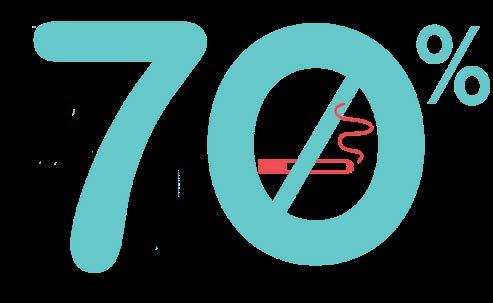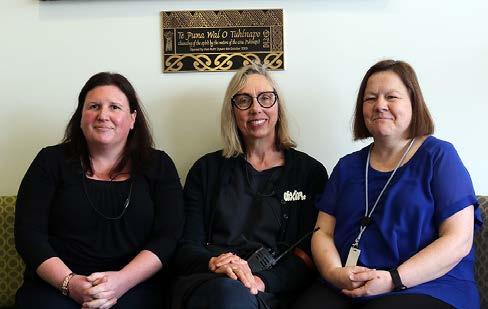
8 minute read
PHAB (Continued
PHAB Continued
During 2019-2020, PHAB continued to focus on its priority areas, and provided the following information and advice to Pegasus:
A letter to Pegasus to endorse the Pegasus Equity Stocktake and congratulate Pegasus on the activities undertaken to improve equity. It was agreed that the stocktake will be updated, and that PHAB will review it every six months. Agreed to review the Pegasus Position Statement on Health and Wellbeing every six months. Regularly reviewed population health data for the Pegasus enrolled population and wider Canterbury population. Congratulated Pegasus on immunisation coverage in 2019 for children aged eight months, and children aged two years, which met the 90% target in all ethnic groups. High immunisation coverage is likely to contribute to lower ASH rates and to lower amenable mortality in future. In the meantime, however, we identified that there are persistent inequities in ASH rates for children aged up to four years. PHAB also identified a lack of recent oral health data for children aged five years, which makes it impossible to assess progress towards improving children’s oral health. PHAB met with members of the Canterbury Clinical Network’s Oral Health Service Development Group (SDG), to identify areas where Pegasus and the Oral
Health SDG could work together. PHAB recommended that Pegasus continue to advocate for fluoridation of drinking water, and that oral health be included as a topic in the Pegasus primary care education programme.
Members of the Oral Health SDG also gave a presentation to PHAB members, and discussions about accessing recent oral health data are underway.
PHAB provided feedback to the Ministry of Health on their Healthy Food and Drink Guidance draft documents.
PHAB endorsed the following:
The Pegasus Equity Stocktake The Pegasus Health Quality Plan Pegasus contribution to the Canterbury Health System Level Measures Improvement Plan The updated Pegasus Smokefree/Auahi Kore position statement
The Equally Well Action Plan to improve the physical health of people with serious mental illness and/or addiction A pilot project to integrate Kaupapa Māori and Pacific NGO nurses into the Pegasus small group education programme Pegasus continuing to provide support to improve access to, and quality of, Gender Affirming Care
Pegasus working with the Culturally and Linguistically
Diverse (CALD) Communities Health Advisory Group, and migrant health professionals, to help them find relevant work experience
Pegasus becoming a member of the Health Coalition
Aotearoa. I wish to thank all the PHAB members for their expertise and commitment to improving the health of the Canterbury population, especially during the COVID-19 pandemic, and the Pegasus Health staff who have provided PHAB with information, advice and support.
PHAB Priorities and Possible Recommendations
March 2019 The Pegasus Population Health Advisory Board (PHAB) was established in March 2018, and first met on 18 April 2018. The Terms of Reference state that the purpose of PHAB is “to provide advice to the PHCL Board on ways that Pegasus can continue to improve health outcomes and reduce health inequities in the Canterbury population, and on occasion, beyond.” Since the establishment of PHAB, we have reviewed relevant reports and other information, and identified the following priorities.
PHAB Priorities
The overarching PHAB priority is to improve equity, and our initial priorities to help achieve this are:
Pacific ambulatory sensitive hospitalisation (ASH) rates for children aged 0-4 years in Canterbury are approximately twice those for Māori and other ethnic groups. The most common conditions are URTIs, asthma, cellulitis, dental conditions, gastroenteritis/dehydration (Halim 2018).
Improve oral health
Socioeconomic gradients in dental caries are evident by age 4 years. Evidence of any caries experience at age 4 years: European 6.8% (6.8 - 6.9), MELAA (Middle Eastern, Latin American and African) 15.0% (14.6 - 15.4), Asian 17.9% (17.7 - 18.0), Māori 22.3% (22.2 - 22.4) and Pacific 30.6% (30.4 - 30.9) (Shackleton et al 2017).
Reduce amenable mortality
Between 2000 and 2014 the age-standardised amenable mortality rate has seen a relative decrease of 39.2% for Māori, 33.6 % for Pacific and 39.2% for nonMāori, non-Pacific populations. The amenable mortality rate was substantially higher for Māori (196.8 per 100,000) and Pacific peoples (186.4 per 100,000) compared with non-Māori, non-Pacific (75.6 per 100,000) in 2014. The top 10 causes are Coronary heart disease, Chronic obstructive pulmonary disease (COPD), suicide, Cardiovascular disease (CVD), breast cancer, diabetes, accidents, rectal cancer, melanoma, prostate cancer. CHD, COPD, CVD, and diabetes accounted for 49% of amenable mortality (Ministry of Health 2017). People with serious mental health problems and/or addiction have higher risks of many chronic health conditions, which contribute to a considerably shorter life expectancy compared with the general population (Cunningham et al 2014, Te Pou o te Whakaaro Nui 2017).
Evidence-informed strategies to address PHAB priorities
The following evidence-informed strategies have been identified:
Primary prevention
Fluoridation of drinking water (PHCL has already acted on PHAB’s recommendation to write to the Minister of Health, Ministry of Health, CDHB, and CCC endorsing fluoridation of drinking water). Decrease risk factors for poor oral health and amenable mortality (decrease tobacco and alcohol use, obesity and poor nutrition - decrease sugar and salt intake, decrease red/processed meat intake). Increase protective factors (increase physical activity, promote breast feeding, promote increased intake of plant-based foods).
Improve access to primary care
Barriers to access are cost (14.3% of adults, 3.0% of children), appointment not available at usual medical centre within 24 hours in past 12 months (18.4% of adults, 15.8% of children), lack of transport (3.2% of adults, 2.6% of children). (Ministry of Health NZ Health Survey 2016/17) Prioritise access for Māori and Pacific to improve equity (for example 9.1% of Māori women and 9.7% of Pacific women reported lack of transport, and 25% of Māori women reported appointment not available at usual medical centre). (Ministry of Health NZ Health Survey 2016/17) Reviews show consistent findings that community health workers (CHWs) can improve access to primary care for disadvantaged/ under-served groups (Jack et al 2016, Kim et al 2016). Most randomised controlled trials have been carried out in the US, but there have been observational studies and evaluations in New Zealand (Bidwell 2013). Shared culture/experience and strong links with the communities they serve, and strong partnerships with providers, are important, and CHWs must be supported by appropriate, accessible services (Gibson et al 2015, Bidwell 2013, Barwick 2000).
Proposed Recommendation
That Pegasus Health develops a Plan to Improve Equity. The plan would include a definition of equity, and would use an evidence-informed approach to improving equity by addressing priorities, including those identified by PHAB, as described on previous pages. Evidence-informed strategies would be included in the Plan, with each strategy to be implemented within a specified timeframe. Measurable outcomes from these strategies would also be included in the Plan.
Evidence-informed examples could include:
Enhancing existing partnerships with other providers to promote primary prevention strategies. This would require funding, communication, a mandate for collaboration, and targeted advocacy, professional education (Wong et al 2017) and collaboration between oral health services, public health, and primary care (Beckett and Meldrum 2018) Appointing new Partnership Community Workers (PCWs); one from the Maori community, one from the Pacific community, and one from the CALD community. Ensuring appropriate pathways are in place to support these appointments. These pathways will include: • Awareness (consult with community groups about suitable links for example, Churches? Clubs? Other organisations?) • Accessibility (ways to help people without access to transport, ways to help with costs of healthcare) • Acceptability (ensuring practices have capacity to accept new patients, and cultural training for practice staff (Neuwelt et al 2015) such as the proposed MIHI pilot project).
REFERENCES
Barwick H.
Improving access to primary care for Māori and Pacific peoples: a literature review commissioned by the Health Funding Authority. Wellington: HFA, 2000.
Beckett DM, Meldrum AM.
Factors that influence inequity of oral health in New Zealand and what we can do about them. In: Health and wellbeing of under-five year olds in the South Island 2017. Dunedin: NZ Child and Youth Epidemiology Service; University of Otago, 2018.
Bidwell S.
Improving access to primary health care for children and youth: a review of the literature for the Canterbury Clinical Network Child and Youth Workstream.Christchurch: Community and Public Health, 2013.
Cunningham R, Paterson D, Sarfati D, Stanley J,
Collings S. Premature mortality in adults using New Zealand psychiatric services. NZ Med J 2014; 127: 31-41. Gibson O, Lisy K, Davy C, et al. Enablers and barriers to the implementation of primary health care interventions for Indigenous people with chronic diseases: a systematic review. Implementation Science 2015; 10: DOI 10.1186/s13012-015-0261-x.
Halim AA. Ambulatory sensitive hospitalisation (ASH) in 0-4 year olds. Christchurch: Pegasus Health Limited, 2018.
Jack HE, Arabadjis SD, Sun L, et al.
Impact of community health workers on use of healthcare services in the United States: a systematic review.J Gen Intern Med 2016; 32: 325-44.
Kim K, Choi JS, Nieman CL, et al. Effects of community-based health worker interventions to improve chronic disease management and care among vulnerable populations: a systematic review. Am J Public Health 2016 doi:10.2105/AJPH.2015.302987.
Ministry of Health.
Health and Independence Report 2017. The DirectorGeneral of Health’s Annual Report on the State of Public Health. Wellington: Ministry of Health, 2018.
Ministry of Health.
New Zealand Health Survey 2016/17 https://www.health. govt.nz/nz-health-statistics/national-collections-and-surveys/ surveys/new-zealand-health-survey#2016-17
Neuwelt PM, Kearns RA, Browne AJ.
The place of receptionists in access to primary care: challenges in the space between community and consultation.Soc Sci Med 2015; 133: 287-295.
Shackelton N, Broadbent JM, Thornley S, et al.
Inequalities in dental caries experience among 4-year-old New Zealand children.Community Dent Oral Epidemiol 2018; 46: 288-296.
Te Pou o te Whakaaro Nui. The Physical Health of People with Mental Health Conditions and/or Addiction: Evidence update December 2017. Auckland: Te Pou o te Whakaaro Nui, 2017.
Wong ST, MacDonald M, Martin-Misener R, et al.
What systemic factors contribute to collaboration between primary care and public health sectors?. An interpretive descriptive study. BMC Health Services Research 2017; 17: DOI 10.1186/s12913-017-2730-1.





